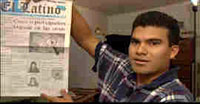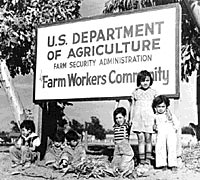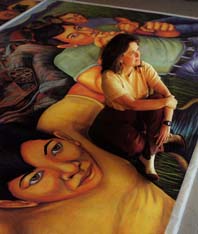| (insert your NIE or newspaper logo here) |
Weekly Online LessonOnline Lesson ArchiveGrade Level: 8-12
|
Latinos Spice Up Melting Pot
 Last month, federal agents raided 60 Wal-Mart stores in 21 states, arresting about 250 janitorial workers. The workers, pegged as illegal immigrants, were all employed by a contractor hired by Wal-Mart, the world's largest retail chain.
Last month, federal agents raided 60 Wal-Mart stores in 21 states, arresting about 250 janitorial workers. The workers, pegged as illegal immigrants, were all employed by a contractor hired by Wal-Mart, the world's largest retail chain.
Last week, on Wednesday, November 5, 2003, the case hit news headlines again when nine of the arrested workers filed a lawsuit against Wal-Mart, accusing the company of discrimination.
Among other points, the plaintiffs charge that Wal-Mart and its cleaning contractors paid the workers lower wages and offered them fewer benefits than other employees, because they are Mexican.
The number of Hispanics (also often referred to as Latinos) living in the United States in 2000 was about 35 million — which translates into a nearly 58 percent increase from 1990, and was caused primarily by high levels of immigration, high birth rates, and the youthfulness of the population.
(The U.S. Census Bureau counts as Hispanic those of Mexican, Puerto Rican, Spanish, Central American, Cuban, Dominican, South American, and other similar origins).
Also in 2000, an estimated 8.7 million illegal, and mostly Hispanic, aliens lived in the U.S. About half a million join their ranks every year, plus over one million transient illegal aliens are here at any given time. Most of these immigrants are drawn by better pay and working conditions compared to that of their native homelands.
As a result, Latino culture is becoming a dominant ingredient in the North American melting pot. We see this in the growing presence of Latino radio stations, television shows, pop music, grocery stores, and bilingual education and media in the American mainstream.
To understand why this upsurge in Latino spice is happening and how it began, this week's you'll uncover the history of early Hispanic workers in the U.S. You'll also meet some of today's Latino citizens, and hear their stories about who they are, where they've come from, and where they're going.
Working For A Living
 Hispanics lived in many parts of the American Southwest even before European pilgrims landed at Plymouth Rock. In the 1840s, following the Mexican-American War, the U.S. government took control of that region.
Hispanics lived in many parts of the American Southwest even before European pilgrims landed at Plymouth Rock. In the 1840s, following the Mexican-American War, the U.S. government took control of that region.
As Anglo-Americans from the east settled the Central and Western regions of North America, they irrigated the arid lands for farming. Coupled with the region's favorable growing climate, fruit and vegetable crops thrived. Job openings for farm workers, and railways, boomed.
To understand how the U.S. government cultivated waves of Latin American immigrants to work on these farms, and in other areas of the U.S., visit The Farmworkers Website and explore The Bracero Project, 1942-1964.
 Begin with What is a bracero?, and click Continue at the bottom of each page to browse through the project site to the section titled, Numbers.
Begin with What is a bracero?, and click Continue at the bottom of each page to browse through the project site to the section titled, Numbers.
What was the Treaty of Guadalupe? Why did World War II influence the influx of migrant workers from Mexico and Latin America? How did other major events in U.S., Latin American, and global history influence the flow of these migrants? Did these workers often receive the benefits they expected?
A few farm workers strived for better pay and treatment from their employers. At the United Farm Workers site, you can meet one of these honored figures — Cesar Chavez.
Why exactly did Chavez form a union? What actions did he take to try to sway policymakers, employers, and public opinion?
Moving Beyond the Farm
 Although some Latinos are transient farm workers, many more are permanent residents, who hold more urban-based jobs. Some Latino families have lived in the U.S. for two or more generations.
Although some Latinos are transient farm workers, many more are permanent residents, who hold more urban-based jobs. Some Latino families have lived in the U.S. for two or more generations.
To discover what this modern living can be like, visit the PBS show's website, American Family. You'll be spending most of your time learning About the Family.
First, check out East L.A., a place that has the highest proportion of Hispanics in the country, at nearly 97 percent. After reading the introductory page, launch the Past and Present Interactive. Click on each point to view images of Chicano/Hispanic events or people related to that place.
In what ways is East L.A. a diverse mix of people? What happened to other ethnic communities that once shared that place with their Hispanic neighbors?
Next, go find out What it means to be Latino. Read all three essays, At the Crossroads: Latinos in the New Millennium, Is There Such a Thing as Latino Identity?, and What It Means To Be Latino.
How do these essayists feel about their ethnic roots and modern identities as Latinos and as individuals? In what ways do the writers feel the same way or differently from each other?
Your last stop here is The Art of the Mural. You can browse more of muralist Judy Baca's work, Our Land Has Memory, at the Denver International Airport.
How does this art form express Latino culture and identity? Why are these murals important as public displays of expression? How do they affect local Hispanic communities? What about non-Hispanic viewers, like those that pass through the Denver International Airport? Can you pick out other forms of art that are clearly influenced by Latino culture?
Newspaper Activities
In a current issue of Targetnewspaper look for articles related to Latino working or living conditions, culture, immigration, or other related news. How does the news affect local Latino communities or individuals? Does the news celebrate their culture in some way? Does the news reflect statistics or conditions that compare differently to similar indicators or factors for other types of ethnic groups or more mixed communities? If the news is about immigration, how does it affect Latinos? How is society, as a region and as the nation as a whole, changing because of Latino influence? In what ways is society resisting Latino influence?
© Copyright 2003
Learners Online, Inc.
